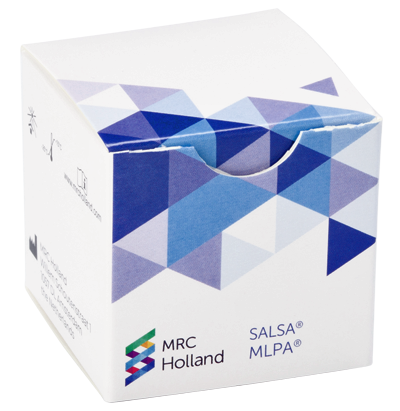Tumour tissues exhibit significant heterogeneity, characterised by varying tumour cell percentages (presence of non-tumour cells) and often subclonal cell expansions as a result of cancer evolution. When extracting DNA from a tumour tissue sample, this includes some DNA from non-tumour cells and genetic information from possible different (sub)clones of the tumour.
digitalMLPA analysis on tumour samples provides information on the average situation in the cells from which the DNA sample was purified. However, if the percentage of tumour cells is low, gains or losses of genomic regions or genes may not be detected. In addition, the subclonality of the aberration affects the inter ratio of the corresponding probe.
In case of a deletion that is present in a lower percentage of tumour cells and/or subclonal, the inter ratio may be higher than expected. For example, a monoallelic deletion in a sample with 60% tumour cell content (or a monoallelic deletion present in 60% of the tumour cells) will result in an inter ratio around 0.70. However, the same inter ratio of 0.70 will also be found in a sample with a biallelic deletion and a tumour cell percentage of 30% (or a subclone comprising 30% of all tumour cells) (this example can be found in bold in Table 1). The digitalMLPA technique cannot discriminate between these two scenarios.
Theoretical inter ratios obtained with digitalMLPA with a specific percentage of cells carrying the aberration can be found below. Estimating the percentage of cells carrying the aberration (tumour cell percentage and/or possible subclonality) could help facilitate the interpretation. As can be appreciated in this table, certain inter ratios can be interpreted in various ways, depending on the tumour cell percentage and/or subclonality.
| Percentage of cells carrying the aberration |
|---|
| 100% | 80% | 70% | 60% | 50% | 40% | 30% | 20% |
|---|
| Normal copy number | 1.00 | 1.00 | 1.00 | 1.00 | 1.00 | 1.00 | 1.00 | 1.00 |
| Monallelic deletion | 0.50 | 0.60 | 0.65 | 0.70 | 0.75 | 0.80 | 0.85 | 0.90 |
| Biallelic deletion | 0.00 | 0.20 | 0.30 | 0.40 | 0.50 | 0.60 | 0.70 | 0.80 |
| One copy gain | 1.50 | 1.40 | 1.35 | 1.30 | 1.25 | 1.20 | 1.15 | 1.10 |
| Two copy gain * | 2.00 | 1.80 | 1.70 | 1.60 | 1.50 | 1.40 | 1.30 | 1.20 |
Table 1: Theoretical expected median inter ratios for aberrations present at different percentages.
As a real-life example of the results of digitalMLPA experiments with different percentages of cells carrying the aberration, DNA from a set of eight Coriell samples and tumour cell lines was diluted with different percentages of "healthy" DNA (without detectable CNAs with SALSA digitalMLPA Probemix D006 Multiple Myeloma). A table with inter ratios observed in this sample set for a specific percentage of cells carrying the deviation (CNA) can be found below.
| Percentage of cells carrying the aberration |
|---|
| 100% | 80% | 70% | 60% | 50% | 40% | 30% | 20% |
|---|
| Normal copy number | 1.01 | 1.01 | 1.01 | 1.01 | 1.01 | 1.00 | 1.00 | 1.00 |
| Monallelic deletion | 0.51 | 0.65 | 0.70 | 0.76 | 0.80 | 0.84 | 0.89 | 0.92 |
| Biallelic deletion | 0.00 | 0.25 | 0.37 | 0.47 | 0.57 | 0.67 | 0.76 | 0.86 |
| One copy gain | 1.48 | 1.35 | 1.31 | 1.25 | 1.20 | 1.17 | 1.11 | 1.06 |
| Two copy gain * | 1.98 | 1.75 | 1.61 | 1.50 | 1.43 | 1.31 | 1.23 | 1.16 |
Table 2: Median inter ratios observed for aberrations present at different percentages when tested with SALSA digitalMLPA Probemix D006 Multiple Myeloma version A1. Please carefully take the variation of the inter ratios within your experiment into account.
* Inter ratios for amplifications (gain of >2 copies) are expected to follow the same trend, with lower values when less cells carry the aberration).
As can be observed in the table above, with lower percentages of cells carrying the aberration, inter ratios of samples with CNAs overlap with the expected normal range of inter ratios (0.85–1.15). We conclude the following: the minimum percentage of tumour cells required for reliable analysis is 30%, which is in line with previously published data (Al Zaabi et al. 2010, Coll-Mulet et al. 2008, Benard-Slagter et al. 2017). We recommend using tumour samples with at least 50% tumour cell content to minimize the variation in tumour cell estimation, and to allow robust data-analysis and detection of potential subclonal aberrations.






